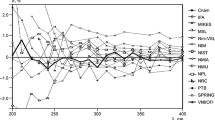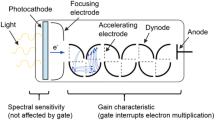Summary
Interference with Li, Na, K, Rb, Cs, Ca and Ba radiations of other constituents (“concomitants”) has been comprehensively surveyed by the Beckman DU quartz spectrophotometer with 9200 flame attachment and 4030 acetylene-oxygen burner.
The “specified”C-I curve, the “concomitant”C-I curve, and “additive” and “multiplicative” interferences have been defined.
It has been found that a “rule of log-log translation” can be applied to many multiplicative interferences. In such cases the multiplicative interferences can be characterized by two constantsm andn, and “concomitant”C-I curves can be expresses mathematically asI=n ·f (m · C) whereI=f (C) is the functional expression of the “specified”C-I curve.
Zusammenfassung
Mit Hilfe eines Beckman-DU-Quarzspektrophotometers mit Zubehör 9200 für Flammenphotometrie und Acetylen-Sauerstoff-Brenner 4030 wurde die Beeinflussung der Emission von Li, Na, K, Rb, Cs, Ca und Ba durch andere Lösungsbestandteile (Begleitstoffe) eingehend untersucht. Die Konzentrations-Intensitäts-Kurve (C-I-Kurve) der zu bestimmenden Substanz, dieC-I-Kurve der Begleitstoffe, additive und multiplikative Beeinflussung wurden definiert. Es wurde festgestellt, daß sich ein „Gesetz der Log-log-Übertragung“ auf viele multiplikative Störungen anwenden läßt. In diesem Fall können solche Störungen durch zwei Konstantenm undn gekennzeichnet werden. DieC-I-Kurven der Begleitstoffe können mathematisch durchI=n·f (m · C) ausgedrückt werden, wobeiI=f (C) die Funktion derC-I-Kurve der zu bestimmenden Substanz darstellt.
Résumé
-
10
Les perturbations apportées par la présence de constituants étrangers («concomitants») aux spectres de Li, Na, K, Rb, Cs, Ca et Ba ont été l'objet d'une étude approfondie à l'aide du spectrophotomètre Beckman DU à quartz équipé du dispositif à flamme 9200 et du brûleur à acétylène-oxygène 4030.
-
20
On a défini la courbeC-I normale, la courbeC-I avec élément concomitant ainsi que les perturbations additives et multiplicatives.
-
30
On a montré qu'une «règle de translation log-log» est applicable à de nombreuses perturbations multiplicatives. Celles-ci peuvent alors être caractérisées par deux constantesm, etn et les courbesC-I «concomitantes» peuvent être représentées mathématiquement par une fonctionI=n ·f (m · C) telle queI=f (C) soit la représentation fonctionnelle de la courbeC-I «normale».
Similar content being viewed by others
References
H. M. Bauserman andR. R. Cerney, Analyt. Chemistry25, 1821 (1953).
S. B. Knight, W. C. Mathis andJ. R. Graham, Analyt. Chemistry23, 1704 (1951).
W. R. Inman, R. A. Rogers andJ. A. Fournier, Analyt. Chemistry23, 482 (1951).
Author information
Authors and Affiliations
Rights and permissions
About this article
Cite this article
Fukushima, S., Shigemoto, M., Kato, I. et al. A relationship between interfering substances in flame spectrophotometry. Mikrochim Acta 45, 35–70 (1957). https://doi.org/10.1007/BF01217493
Received:
Issue Date:
DOI: https://doi.org/10.1007/BF01217493




